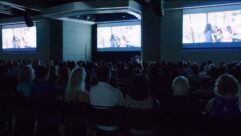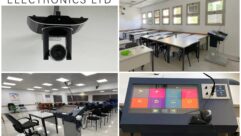
New Church, New AV Gear, Part 2
Mar 24, 2011 11:48 AM,
with Bennett Liles
Listen to the Podcasts
|
Editor’s note: For your convenience, this transcription of the podcast includes timestamps. If you are listening to the podcast and reading its accompanying transcription, you can use the timestamps to jump to any part of the audio podcast by simply dragging the slider on the podcast to the time indicated in the transcription.
The Family Church of the Southern Tier in Jamestown, New York built a new sanctuary and they called Turner Specialty Contractors to completely outfit it with sound, lighting, and projection. Randy Turner is back to wrap up his talk about the church and how the project came out. That’s coming up next on the SVC podcast.
Randy, thanks for being back with me for Part 2 on the SVC podcast from Turner Specialty Contractors. We were talking about the big AV installation project you did at the Family Church of the Southern Tier in Jamestown, New York. You put in a Shure ULX wireless mic system there. Did you have any unexpected situations come up on the mics during that job?
Well frankly it came together pretty easily. I had bigger issues frankly with my video…we put a Christie video projector up on the ceiling and it’s, I forget, 37ft. up so it’s not exactly easy to access and I had a million ground loop problems even though we had put isolation transformers on the whole system. That was really the big issue. The wireless mics, they went very, very smoothly. [Timestamp: 1:29]
Well they’re probably a little easier to get to than the projectors. That’s front projection isn’t it?
Yes, yes, yes; yeah so you’re running baluns to change your signal over a Cat-5 because there again I have about 220ft. where the cable runs so you can’t use the VGA cable very well and so we did the baluns on both ends and I just had issue after issue for several weeks until finally we just lifted the grounds and 99 percent of the ground pulled away. But those are the hard things because you’re always at the end of a job, when you do a new construction like this, you’re always the last guy in the building and so they’re always rushing to get you out of the building because they want to obviously open up for Sunday morning and they opened on Easter last year and so there was really a big rush to get us out and I was promised to have an empty building there for several days and because of everyone’s schedule it really didn’t happen and the next thing you know you lose a lift and the lift is gone on Easter and you can’t access that video projector 37ft. above your head. How do you fix it? That was a bigger issue. The next thing you know we had to wait a week until everybody got calmed down and had to bring a lift back in and they weren’t thrilled about that with a brand-new facility having a big monster lift. They didn’t want marks on the carpet and all that but we finally…we finally got it working right. [Timestamp: 2:43]
Yeah that’s a lousy situation when you’re dragging cable around, drilling through walls, heaving gear all over the place to get the job done right and you turn everything on and find something like hum bars going through the video display. That’s a real morale killer.
Yes it is and for a minute I thought it was going to be a paycheck killer too bad as I had a…they’re always holding off on final pay until proof that everything is 100 percent and boy you get a little bit nervous frankly because everyone says this should work and you call the tech people at all the different companies and nobody could figure it out. And then finally I put the brain back on and said, “Well how did we do it the old days?” and in the old days I would go lift grounds and so I lifted grounds and boom, it finally went away. [Timestamp: 3:24]
Well experience is the best buddy to have along with all kinds of little pocket widgets for lifting ground and isolators for keeping sound and lighting gear from going to war with each other. Now the stage monitoring in this church that was Aviom, am I right?
That was Aviom and we actually did all the Aviom in-ear mixers. So you have those personal mixers everyone’s had I think there were seven of them up there and that works great but their concern is they bring in a lot of traveling Christian artists and how are they going to work with it?—they don’t know it, what not and they felt much more comfortable by having two stage monitors on the stage as well at all times and so they don’t use those except for the special events but the day to day, the regular band—every Sunday morning band, they all live on the Aviom system. [Timestamp: 4:1]
Is that fed out of a DA or an aux off of the FOH board?
Well the Aviom actually couples off of…the way we wired is it is it came off a lot of the aux’s but they also wanted a couple of direct outs because they wanted just to be able to take a pure signal in especially I think it was off the pastor’s mic, they wanted to be able to run that through an aux for whatever reason. These guys are pretty techno savvy at this church and so if that’s what they want to do that’s fine and so we wired it that way and it works just fine. [Timestamp: 4:37]
In most of the church situations I’ve seen even if the musicians and performers are a little hesitant at the beginning they end up just loving the Aviom system where they can just bring up their own instrument full blast and just feel around it with whatever they want.
Well it’s an education process too isn’t it? The first…well the first two hours we had it up and running on the very first night of rehearsal before the big Easter opening there again it’s the education process, you got guys mixing a brand-new board—had a huge brand-new Crest board there and so they’re a little intimidated by that and they’re a little intimidated by being in this brand-new gorgeous room and the speakers are different and everything’s different. And so it took…it really took about two to three hours before the musicians started getting comfortable with the in-ear monitors. Now it’s been almost a year, they wouldn’t do anything but the in-ear monitor. But you just got to get them through the education. [Timestamp: 5:23]
Yeah it’s a big adjustment for some performers who are accustomed to using floor monitors. They seem to feel a little isolated with the IEM at first but if they have a little ambience sound mixed in you can gradually wean them off that.
Yeah that’s a good way of putting it. Yes. [Timestamp: 5:38]
New Church, New AV Gear, Part 2
Mar 24, 2011 11:48 AM,
with Bennett Liles
And you’ve got some volunteer tech folks to train and a lot of times the new sound people seem to have this idea in their heads that EQ knobs only turn to the right.
I have a cute little story for you about it. I once did a Lutheran church not too far from here a number of years back and we had set up everything and Sunday morning was great and everyone was happy and we walked away. And the next Sunday morning I had a phone call from one of the deacons complaining about my system. And I went back and I realized that somebody had changed a bunch of EQ knobs and I put them back where they’re supposed to be and next Sunday I got another phone call from the deacon and that went on for four weeks just complaint after complaint after complaint and finally I think it was…it might have been the pastor who finally took a hint and started watching. There was an 86-year-old grandmother in the church who had Alzheimer’s and she thought that those knobs being in different positions were all wrong, they all should be pointing at noon so she would change them every single time that she was in the church. [Timestamp: 6:35]
Well that’s always entertaining.
It was—we finally locked up the board so that the grandma can’t get to it anymore. [Timestamp: 6:43]
Yeah that sounds like a little bit of a FOH security situation. You mentioned this before I think what kind of a mixer have they got out in the FOH?
It’s a Crest. It’s a 40-channel Crest board. It’s a beast. I’ve done Soundcraft, I’ve done Crest, I’ve done Yamahas, and for whatever reason I think the church was the one who picked the Crest board out and so that’s what we went with. [Timestamp: 7:05]
And of course there’s always been a little bit of a debate on the advantages and disadvantages of digital vs. analog boards for churches.
Well the biggest dilemma I find, Bennett, in working with churches is the experience, education, skill level—whatever you want to call it—of the tech team and trying to get them jump the loop up to a digital board. Without having experienced trained staff on board it’s a little tricky. [Timestamp: 7:33]
Yeah it can be intimidating.
Yes.
…for some people.
Yes. And the problem as the installer, who are they going to point fingers at? They’re going to pointing fingers at you even though it’s their people that don’t understand the equipment and that’s touchy. And so I try to keep things simple frankly—that’s always been one of my values that are…I just try to keep things simple for these guys and not unless they’ve really got a full-time tech person. I’ve done several…some churches that do that and that’s fine. They’ve got a full-time tech guy and this is what their whole life is about. Fine, we’ll stick the digital equipment in there and they can have a good time but other churches like this they don’t have full-time tech people. These are all volunteers and so it’s a little touchier. Timestamp: 8:1]
And then they’ve got lighting to deal with. Where’s the lighting control point in the church?
It’s also up in the…there is a balcony rail where they built all this equipment into. They’ve got an ETC 96-channel sensor rack that we put in. It’s a sweet system. We’ve got a whole bunch of Parnells up there and about eight Wiekos as well. And so it gives them a lot of color, it gives them a lot of light and it really…it’s quite the system. Then on the background the wall is 37ft. tall—it’s a basically 80×80 box for the sanctuary and in that box I have a video projection off of that Christie video projector. It lights up the wall 16’x9′ tall, it’s almost 29ft. left to right and that’s my video projection. So it takes up almost the entire back wall width-wise and up to 16 ft 9ft. high and yet I can control those Parnells. I can keep enough light from bouncing off the wall and so you still have a lot of punch on that wall and that wall has been painted with Goo System. That’s a high-reflectivity paint that’s now available for video walls. It’s not cheap. I think the…I don’t do the paint and I don’t want to ever be a painter and I think the painter came in a little over $5,000 just to paint that one wall with Goo Systems. I believe he told me he’s got five coats of Goo Systems on there. It’s an amazing product. You get rid of the video screen. So I don’t have some ugly video screen up there I just have a wall and it blends in with all the other three walls in the building. t’s a similar color and yet when you turn on a video projector your bounce-back is greater than 100 percent it’s more like a gain. If you have a good daylight video screen you can get a gain up to 1.5 or so and that gain on that Goo System is also very, very high and it works exceptionally well. The trick was to keep the Parnells from bouncing too much up on that wall. That’s the real trick. [Timestamp: 10:03]
And the big thing is that you can change the whole mood and atmosphere of the service or whatever event they’re doing there with just some simple changes in lighting and projection. So do they broadcast or stream their services at all or just record and do media distribution?
No, they’re getting into streaming this year. Now I don’t…that’s not my end of life somebody else is taking care of that part but I understand they’re going to get into that this year. [Timestamp: 10:24]
And your outfit had to come in after the install and train the crew and with the volunteer situation you usually have there that’s usually an ongoing operation.
It is with most churches yeah because…especially because the turnover of personnel but yeah we always make sure we train them and then we’re always there. We always guarantee in our contracts we’ll be there the first Sunday no matter what and then we just babysit in the background and if they need us we’re there. And at the same time I like to go in every six months regardless and just to watch and to see how they do a Sunday service and see how it’s working. And their guys are doing a fine job but we went in and tuned up some things after six months and made it a little better and they’re very happy campers. [Timestamp: 11:05]
OK well it sounds like they’ve got plenty to be happy about. They’ve got Shure ULX mics, Aviom stage monitoring and a whole system that was put in on new construction and one company to deal with on the whole thing. It’s Turner Specialty Contractors and the Family Church of the Southern Tier and thanks to you Randy Turner for taking time out to tell us about the project.










